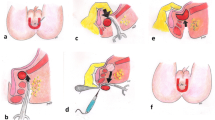Abstract
Background
Anismus or non-relaxing puborectalis muscle (PRM), detectable with anal/vaginal ultrasound (US), is a cause of obstructed defecation (OD) and may be treated with biofeedback (BFB). Many patients with anismus are anxious and/or depressed. The aim of this prospective study was to evaluate the outcome of the novel procedure psycho-echo-BFB in patients with anismus and psychological disorders.
Methods
Patients presenting at our unit with anismus and psychological disorders between January 2009 and December 2013, and not responding to conventional conservative treatment, were enrolled in the study. All underwent four sessions of psycho-echo-BFB, carried out by two psychologists and a coloproctologist, consisting of guided imagery, relaxation techniques and anal/vaginal US-assisted BFB. A validated score for OD was used, and PRM relaxation on straining measured before and after the treatment. PRM relaxation was also measured in a control group of 7 patients with normal bowel habits.
Results
Ten patients (8 females, median age 47 years, range 26–72 years) underwent psycho-echo-BFB. The OD score, evaluated prior to and at a median of 25 months (range 1–52 months) after the treatment, improved in 7 out of 10 patients, from 13.5 ± 1.2 to 9.6 ± 2.2 (mean ± standard error of the mean (SEM)), p = 0.06. At the end of the last session, PRM relaxed on straining in all cases, from 0 to 7.1 ± 1.1 mm, i.e., physiological values, not statistically different from those of controls (6.6 ± 1.5 mm). Two patients reported were cured, 3 improved and 5, all of whom had undergone prior anorectal surgery, unchanged. No side effects were reported.
Conclusions
Psycho-echo-BFB is safe and inexpensive and allows all patients with anismus to relax PRM on straining. Previous anorectal surgery may be a negative predictor.



Similar content being viewed by others
References
Pescatori M, Spyrou M, Pulvirenti d’Urso A (2007) A prospective evaluation of occult disorders in obstructed defecation using the “Iceberg diagram”. Colorectal Dis 9:452–456
Brusciano L, Limoncelli P, Pescatori M et al (2007) Ultrasonographic pattern in patients with obstructed defaecation. Int J Colorectal Dis 969–977
Pucciani F, Iozzi L, Masi A, Cianchi F, Cortesini C (2003) Multimodal rehabilitation for faecal incontinence: experience of an Italian centre devoted to faecal disorder rehabilitation. Tech Coloproctol 7:139–147
Solomon MJ, Pager CK, Rex J, Roberts R, Manning J (2003) Randomized, controlled trial of biofeedback with anal manometry, transanal, ultrasound, or pelvic floor retraining with digital guidance alone in the treatment of mild to moderate fecal incontinence. Dis Colon Rectum 46:703–710
Spielberger CD, Gorsuch RL, Lushene R (1970) The State-trait anxiety inventory (S.T.A.I.). Test Manuel for form X. Consulting psychologist press, Palo Alto
Miliacca C, Gagliardi G, Pescatori M (2010) The Draw-the-Family-Test in the preoperative assessment of patients with anorectal disease and psychological distress: a prospective controlled study. Colorectal Dis 12:792–798
Altomare DF, Spazzafumo L, Rinaldi M, Dodi G, Ghiselli R (2008) Set-up and statistical validation of a new scoring system for obstructed defaecation syndrome. Colorectal Dis 10:84–88
Diane L, Tusek RN, Church JM, Strong SA, Grass JA, Fazio VW (1997) Guided imagery. Dis Colon Rectum 40:172–178
Renzi C, Peticca L, Pescatori M (2000) The use of relaxation techniques in the perioperative management of proctological patients: preliminary results. Int J Colorectal Dis 15:313–316
Taffinder NJ, Tan E, Webb IG, McDonald PJ (2004) Retrograde commercial colonic hydrotherapy. Colorectal Dis 6:258–260
Block IR (1986) Transrectal repair of rectocele using obliterative suture. Dis Colon Rectum 29:707–711
Lau CW, Heymen S, Alabaz O, Iroatulam AJ, Wexner SD (2000) Prognostic significance of rectocele, intussusception, and abnormal perineal descent in biofeedback treatment for constipated patients with paradoxical puborectalis contraction. Dis Colon Rectum 43:478–482
Maria G, Sganga G, Civello IM, Brisinda G (2002) Botulinum neurotoxin and other treatment for fissure-in-ano and pelvic floor disorders. Br J Surg 89:950–961
Farid M, Youssef T, Mahdy T et al (2009) Comparative study between botulinum toxin injection and partial division of puborectalis for treating anismus. Int J Colorectal Dis 24:327–334
Farid M, El Nakeeb A, Youssef M, Omar W, El Monem HA (2010) Comparative study between surgical and non surgical treatment of anismus in patients with symptoms of obstructed defecation. A prospective randomized study. J Gastrointest Surg 14:1235–1243
Dolk A, HolmStrom B, Johansson C, Frostell C, Nilsson BY (1991) The effect of yoga on puborectalis paradox. Int J Colorectal Dis 6:139–142
Bouchoucha M, Devroede G, Arsac M (2004) Anismus: a marker of multi-site functional disorders? Int J Colorectal Dis 19:374–379
Pescatori M (2009) Long-term follow-up of simultaneous abdominoperineal repair of enterorectocele and internal mucosal prolapse. Dis Colon Rectum 5:335–337
Devroede G (1995) Psychological considerations in subjects with chronic idiopathic constipation.In: Wexner SD and Bartolo DCC (eds) Constipation: etiology, evaluation and management. London, Butterworth Heinemann, pp 103–104
Phillips RKS, Lunnis PJ (eds) (1996) Anal Fistula. Evaluation and management. Chapman & Hall Medical, London
Favetta U, Amato A, Interisano A, Pescatori M (1996) Clinical, Manometric and sonographic assessment of the anal sphincters a comparative prospective study. Int J Colorectal Dis 11:163–166
Pescatori M, Anastasio G, Bottini C, Mentasti A (1992) New Granding and scoring for anal incontinence. Evaluation of 335 patients. Dis Colon Rectum 35:482–487
Kamm MA, Hoyle CH, Burleigh DE et al (1991) Hereditary internal anal sphincter myopathy causing proctolgia fugax band constipation. A new identified condition. Gastroenterology 100:805–810
Bartram CI, Pescatori M, Regadas FSP, Regadas Muras S (2009) Imaging atlas of the pelvic floor and anorectal disease, Springer
De Nardi P, Bottini C, Scucchi LF, Palazzi A, Pescatori M (2007) Proctalgia in a patient with staples retained in the puborectalis muscle after STARR operation. Tech Coloproctol 11:353–356
Heymen S, Wexner SD, Gulledge AD (1993) MMI assessment of patients with functional bowel disorders. Dis Colon Rectum 36:593–596
Conflict of interest
None.
Author information
Authors and Affiliations
Corresponding author
Rights and permissions
About this article
Cite this article
Del Popolo, F., Cioli, V.M., Plevi, T. et al. Psycho-echo-biofeedback: a novel treatment for anismus—results of a prospective controlled study. Tech Coloproctol 18, 895–900 (2014). https://doi.org/10.1007/s10151-014-1154-8
Received:
Accepted:
Published:
Issue Date:
DOI: https://doi.org/10.1007/s10151-014-1154-8



